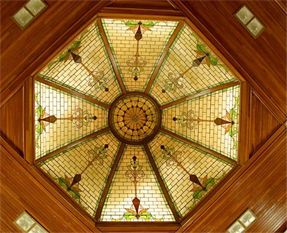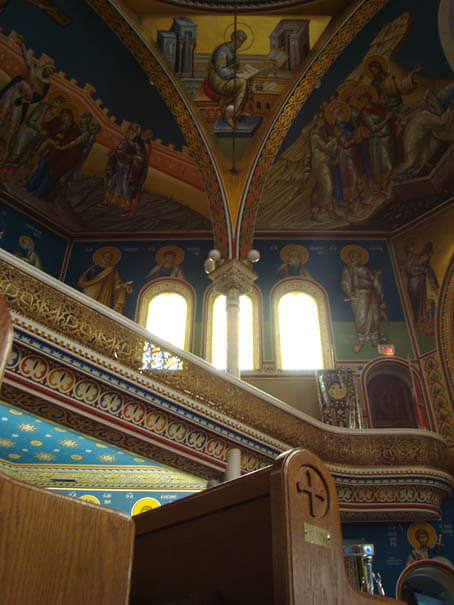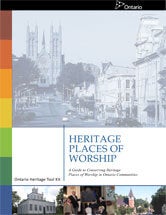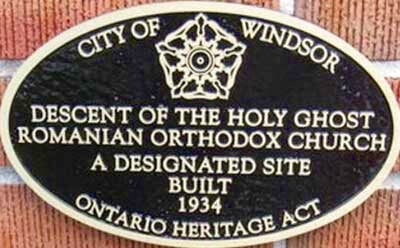
Stained glass dome, Highgate United Church, now Mary Webb Cultural and Community Centre, Highgate
There’s something else about churches…
Back to basics for a minute. Built heritage conservation is not supposed to be about use (as long as there is a viable one of course!). So whether an old factory is used for its original industrial purpose, adapted for commercial use or turned into chic condos is all the same — right? — provided its heritage features are identified and respected along the way. Heritage is about the fabric or “bricks-and-mortar,” the physical features of the place; while what takes place within/on that fabric/property — the way it is used — is pretty much irrelevant.
This at any rate is the premise of our chief tools for legal protection — heritage designation and heritage easements under the Ontario Heritage Act (OHA). They do not in themselves restrict (or permit) the use that can be made of a property or place. Zoning, our basic land use planning mechanism, does that.
And yet, we do accept that a heritage structure continuing in its original use is the best of all scenarios. From the Appleton Charter:
Use — A property should be used for its original purpose. If this is not feasible, every reasonable effort shall be made to find a compatible use which requires minimal alteration.[1]
So continuing original use is almost always preferable to adaptive re-use. Why? Obviously it’s simpler, less complicated. Adaptive re-use involves, well, adaptation and intervention — physical changes which may have an impact on heritage attributes. But it’s more than that. Something else inevitably melts away when an old building is repurposed (as we now like to say) and its traditional use ends. Something intangible. Hard therefore to nail down, but having to do with a heightened sense of place, nearness of the past, consciousness of continuity. Sometimes we call this, rather inadequately I think, authenticity.
Nowhere is this more the case than with churches, places of worship, places where generations of people have come together as a community to celebrate their faith. A church repurposed, even to the highest conservation standards, can’t help but be a shell of what it was… you could go so far as to say its “soul” has been lost.[2]
Indulging the metaphor, this may help explain the reluctance of some faith organizations to save the “body” (the fabric) when the “soul” (the spiritual focus) of a building is no more. Unfortunately they sometimes choose to overlook the possibility that their place of worship could continue to serve as another group’s place of worship.

St. George's Greek Orthodox Church, formerly a synagogue (Holy Blossom Temple), Toronto
For public policy, all this suggests that special measures should be considered to keep heritage places of worship as just that — places to worship — as well as to help overcome barriers to adaptive re-use when that’s not possible. What might these be?
To start, tax-exempt status clearly benefits continuing use by faith organizations and should be maintained. To facilitate ongoing use, heritage restrictions must be applied very gingerly, especially when it comes to alterations for liturgical reasons and for meeting a congregation's current needs. But to really improve things there needs to be meaningful financial incentives to help with religious building conservation — to fix that roof! — incentives which Ontario, unlike Quebec, currently (and for way too long) doesn't have.[3]
But lately Ontario has been doing some things well. Inventories of course are vital and, at the provincial level, the Ontario Heritage Trust has compiled a mammoth and ongoing on-line inventory of Ontario’s places of worship. The Ministry of Tourism, Culture and Sport, for its part, recently added a guide to preserving and protecting religious properties to its popular Ontario Heritage Tool Kit.[4]

After many, many years of doing bubkas for churches, what was the spur for these provincial initiatives? Therein lies quite a tale… for next time.

Notes
Note 1: The Appleton Charter for the Protection and Enhancement of the Built Environment, ICOMOS Canada (English-Speaking Committee), 1983.
Note 2: The Ontario Heritage Act defines “heritage attributes” (a term used in the Act only in the context of heritage designation) narrowly: “in relation to real property, and to the buildings and structures on the real property, the attributes of the property, buildings and structures that contribute to their cultural heritage value or interest.” Use is not mentioned, nor does the word appear in the designation criteria in Reg. 9/06 and 10/06. By contrast, the non-legislative Standards and Guidelines for the Conservation of Historic Places in Canada takes a broader, looser approach, defining “character-defining elements” as “the materials, forms, location, spatial configurations, uses and cultural associations or meanings that contribute to the heritage value of an historic place, which must be retained in order to preserve its heritage value” (underlining added).
Note 3: In the last 20 years the Quebec government has funnelled close to $300 million to the Conseil du patrimoine religieux du Quebec for the safeguarding of that province's religious heritage (both immoveable and moveable). The last time the Ontario government had a grant program targeted to built heritage conservation, including churches, was the Heritage Challenge Fund of 1999-2001, which provided just five million dollars on a matching basis for the whole province.
Note 4: Check out the Trust's Ontario's Places of Worship Inventory. The site includes a few case studies — with hopefully more to come — and some good links. See the ministry's guide, "Heritage Places of Worship: A Guide to Conserving Heritage Places of Worship in Ontario Communities (PDF)".
In 2009 the Trust also organized, with Heritage Canada (now the National Trust for Canada), an important roundtable on the preservation of places of faith. See the roundtable minutes (PDF). One of the most interesting presentations profiled Partners for Sacred Places, a U.S. organization that provides information and guidance to congregations and communities to sustain use of historic sacred places: Partners for Sacred Places.